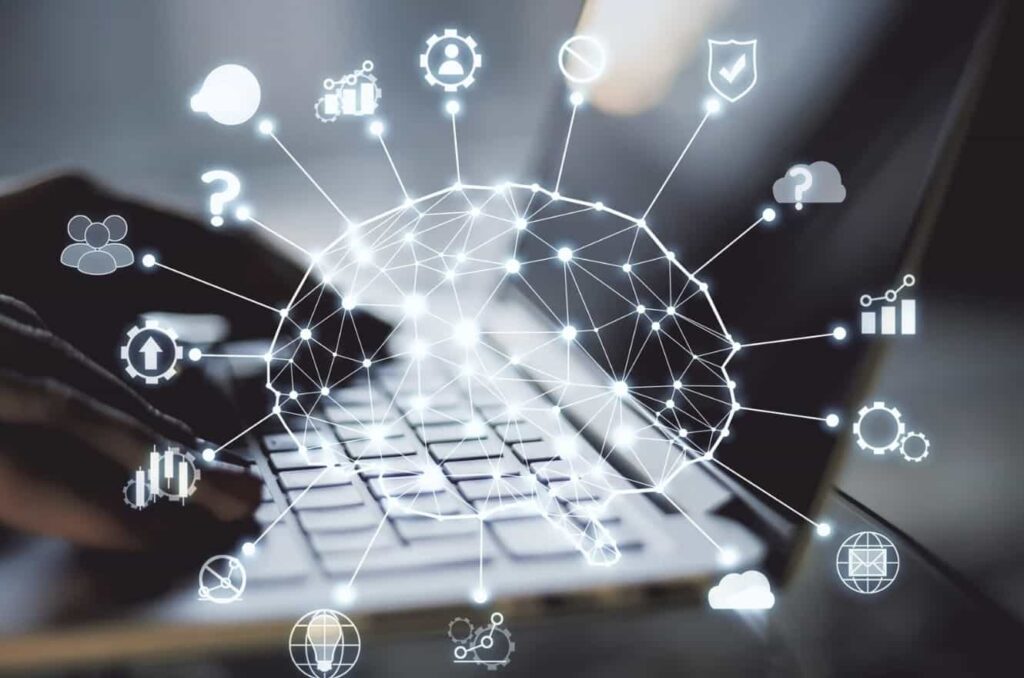Artificial intelligence (AI) is transforming work. Forrester estimates AI software spending to reach US$64 billion by 2025.
Sustainable business growth comes with a people-first mindset even while integrating new technologies. Here are five ways enterprises can leverage AI to unlock the potential of the human workforce.
1. Automate repetitive tasks.
The real benefit of AI in the workplace is empowering the human workforce to do greater things. AI automates routine and basic-level tasks that are time-consuming for humans. In many enterprises, AI becomes a digital assistant that takes over the bulk of analytical or technical tasks.
The benefits of automating such repetitive and time-consuming tasks are multi-fold.
Human employees, free of time-consuming tasks, have more time to focus on higher-value tasks. Many employees feel demotivated after doing machine-like repetitive tasks day in and day out. Taking up higher-value tasks allows them to add more value to the organisation. Their job satisfaction and motivation levels increase. They feel more committed to the enterprise, and attrition rates come down.
Human workers will become more effective. Gartner’s recent Digital Worker Experience Survey reveals that 47% of the digital workforce struggle to find data and information. AI-powered bots may work alongside humans to offer relevant insights.
Use cases abound.
Amazon, the e-commerce giant, deploys AI to help warehouse workers pick and pack items more quickly and accurately. Human employees continue to pick and pack. AI optimises the picking and packing routes and identifies potential errors. Process accuracy and speed improve. Overheads come down, and customers get their products faster.
Sales executives spend a lot of time assessing leads, only to find that many are duds. Salesforce uses AI to help sales representatives identify and qualify leads. The insights generated by AI help sales reps focus their time and energy on the most promising opportunities and close deals faster.
The World Economic Forum estimates that 43% of all work tasks will get automated by 2027. This will give employees more time for learning, development, and work that makes a real impact.
2. Improved collaboration and communication
AI-powered collaboration tools ease communication and collaboration. Smooth communication and collaboration improve teamwork, improving synergies and work output.
AI-powered chatbots:
- Streamline field service communications. Field technicians use their smartphones to connect to bots that offer all relevant information. These apps may even guide them to resolve complex issues. The field service technicians do not have to schedule a revisit, waste time on clarifications, or work based on hunches.
- Facilitate self-service for internal transactions and reduce friction. AI-powered chatbots handle clerical tasks such as leave processing and payroll information. But this is not enough. Employees from different backgrounds work together in today’s multicultural environment.
- Connect with remote, deskless workers at scale and in more personal ways. About 80% of the post-pandemic global workforce is deskless. While this work culture reduces overheads, most deskless employees feel disconnected and disengaged.
Anthill, the mobile-based communications platform, uses AI communication tools to provide workers with round-the-clock access to job and company-specific information. The integrated app also offers automatic translation, catering to the needs of a diverse and multinational workforce.
SAP’s Joule is a new generative AI assistant that allows users to interact with SAP’s apps in a conversational way. Joule uses natural language processing to help employees find information, get answers, clock in and out, and perform other tasks.

3. Improved decision making
A popular use case for AI bots in the enterprise is data analytics. Purpose-built AI tools automate data gathering, cleansing, and interpretation. AI algorithms analyse large datasets to draw insights beyond human cognitive ability.
Such contextual insights and recommendations allow employees to make better decisions. For example, AI algorithms
- Predict customer demand
- Identify potential problems and recommend solutions. AI algorithms analyse data flows to identify patterns and detect anomalies, which human analysis and first-generation computers cannot do.
- Streamline field service scheduling. AI-powered field service solutions schedule technician service calls. The algorithms consider assigned jobs, upcoming leaves, worksite location, and other factors to pre-empt clashes. Such intelligent scheduling ensures field agents spend a minimum of time on the field. The algorithm also automates changes, which impact other schedules. Doing the same in manual mode is complex and error-prone, often leading to huge inefficiencies and loss of productivity.
4. Generative AI opportunities
The rise of generative AI has unlocked huge possibilities in coding, design, and content generation. The EY 2023 Work Reimagined Survey estimates 84% of employers to have implemented generative AI within the next 12 months. These enterprises expect improved productivity and greater possibilities through new ways of working.
Generative AI converts user input to custom code, designs, data analysis, emails, reports, or other content.
Generative AI tools:
- Write code, suggest code snippets, and identify potential errors. AI has also powered the rise of low-code and no-code solutions. These solutions help business users develop applications with little or no coding expertise. They can get their jobs done fast without waiting for the IT team to do it.
- Assist designers in ideation and creative processes. The algorithm analyses market trends, customer feedback, and competitor data. These insights offer the basic data to fuel innovation and channel creativity in the right direction. These tools consider more variables than what a human brain can process within time and budget constraints.
- Generate marketing pitches, emails, and other content.
All these tasks, however, require human involvement. Entrusting AI to roll out a design or publish a blog is a recipe for disaster. But marketers and designers can use these generative AI solutions to lay the groundwork and build on the AI-generated basic draft. Their work productivity improves manifold, and they have more time to be creative and innovate.
5. Skill enhancement and training
The large-scale introduction of AI and related technologies has disrupted the way of work. To cope with the disruption, enterprises need to upskill and reskill, attract and retain the right people. Here again, AI tools come to their rescue.
AI tools
- Performing rolling analyses on employee performance indicators recommends training and upskilling opportunities. Thus, the reactive performance appraisal process becomes a proactive performance management exercise.
- Offer personalised learning and development experiences that cater to individual learning styles. AI algorithms understand employees’ strengths and weaknesses. It then syncs upcoming business requirements to create personalised learning and development experiences. The algorithms identify skill and knowledge gaps to suggest relevant training and development.
Enterprises that deploy AI can unlock the potential of their human workforce. An AI-empowered workforce becomes more productive and efficient. They get more time and energy to innovate. Likewise, customers also benefit through faster time-to-market and lower costs.












